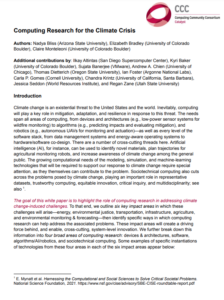 Earlier this week the Intergovernmental Panel on Climate Change (IPCC), which is the United Nations body for assessing the science related to climate change, released their Climate Change 2021- The Physical Science Basis Report.
Earlier this week the Intergovernmental Panel on Climate Change (IPCC), which is the United Nations body for assessing the science related to climate change, released their Climate Change 2021- The Physical Science Basis Report.
The report is sobering. We know that human activity is changing the climate in unprecedented and sometimes irreversible ways, but this recent report warns of increasingly extreme heatwaves, droughts and flooding, and a key temperature limit being broken in just over a decade. It shows how catastrophic the outlook will be if we don’t act now.
The Computing Community Consortium (CCC) has released a new whitepaper on Computing Research for the Climate Crisis, coauthored by Nadya Bliss (Arizona State University), Elizabeth Bradley (University of Colorado Boulder), and Claire Monteleoni (University of Colorado Boulder), to highlight the role of computing research in addressing climate change-induced challenges.
Six key areas of impact in which these challenges will arise—energy, environmental justice, transportation, infrastructure, agriculture, and environmental monitoring & forecasting—are outlined, and then specific ways in which computing research can help address them are identified. They then are further broken down into four broad areas of computing research: devices & architectures, software, algorithms/AI/robotics, and sociotechnical computing. Some examples of specific instantiations of technologies from these four areas in each of the six impact areas appear below:
Energy
- Hardware: Sensors and sensor networks for monitoring power generation and consumption; energy-harvesting devices
- Software: Managing, cleaning, fusing, and distributing heterogeneous data from multiple sources
- AI/Robotics/Algorithms: Planning, optimization, and decision support for production, distribution, and consumption of energy; AI-enabled materials science for renewables
- Sociotechnical: Appropriate cost functions for optimization; communicating about decisions
Environmental justice
- Software: Rich data sets and models that properly capture and expose equity aspects, hidden biases, and economic factors
- AI/Robotics/Algorithms: Modeling and decision-support strategies that leverage those data and manage cascading risks
- Sociotechnical: Critical inquiry methodology, question- (vs. solution-) driven science, and stakeholder engagement
Transportation
- Hardware: Sensors and sensor networks for monitoring salient variables (traffic, goods, people, pollution, energy availability & needs, etc.)
- Software: Managing and disseminating data; creating effective models that couple those variables with economic forces and constraints
- AI/Robotics/Algorithms: Spatiotemporal planning strategies to optimize the routing of flows in the network
- Sociotechnical: Helping people understand how and why to act in this new system
Infrastructure
- Hardware: Sensors and sensor networks for monitoring roads, bridges, communication networks, etc.
- Software: Smart database management for lifetime of materials
- AI/Robotics/Algorithms: Optimization and decision support of flows of energy, goods, water, vehicles, people, power, etc.; AI-enabled materials science for green materials
- Sociotechnical: Equitable distribution and access to new technology (e.g. renewable energy, grid resiliency, power); stakeholder engagement
Agriculture
- Hardware: Sensors and sensor networks for monitoring water, temperature, crop growth, etc.
- Software: Systems for deployment and control of autonomous vehicles (e.g., UAVs)
- AI/Robotics/Algorithms: Algorithms that leverage rich sensor data, together with real-time information about economic factors and transportation networks, for planning and risk assessment
- Sociotechnical: Stakeholder engagement
Environmental monitoring and forecasting
- Hardware: Sensors and sensor networks for monitoring temperature, CO2 levels, ice coverage, etc.
- Software: Detection and diagnosis of sensor failure; managing assimilation of data into models
- AI/Robotics: Uncertainty quantification; system-level, risk-sensitive modeling, planning, and optimization strategies for climate variables, at all scales
- Sociotechnical: Ensuring saliency, credibility, and legitimacy in decision support systems
The climate crisis introduces new grand challenges for computing research. Solutions to these problems will require advances in all areas of computing, carried out by interdisciplinary teams that bring together computing researchers with colleagues from the social, behavioral, and economic sciences—as well as the physical sciences and engineering—and coordination between sectors. This type of deep, coordinated interdisciplinary approach will not only facilitate transition of novel research (via stakeholder engagement, for example), but more importantly, it will help ensure that innovations are distributed equitably and take into account vulnerable communities.
See the full report to learn more.









